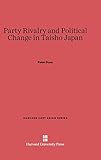Party Rivalry and Political Change in Taisho Japan / Peter Duus.
Material type: TextSeries: Harvard East Asian Series ; 35Publisher: Cambridge, MA : Harvard University Press, [2013]Copyright date: ©1968Edition: Reprint 2013Description: 1 online resource (317 p.) : 1 chart, 10 tablesContent type:
TextSeries: Harvard East Asian Series ; 35Publisher: Cambridge, MA : Harvard University Press, [2013]Copyright date: ©1968Edition: Reprint 2013Description: 1 online resource (317 p.) : 1 chart, 10 tablesContent type: - 9780674330665
- 9780674330672
- 329.9/51
- DS886 .D88
- online - DeGruyter
| Item type | Current library | Call number | URL | Status | Notes | Barcode | |
|---|---|---|---|---|---|---|---|
 eBook
eBook
|
Biblioteca "Angelicum" Pont. Univ. S.Tommaso d'Aquino Nuvola online | online - DeGruyter (Browse shelf(Opens below)) | Online access | Not for loan (Accesso limitato) | Accesso per gli utenti autorizzati / Access for authorized users | (dgr)9780674330672 |
Browsing Biblioteca "Angelicum" Pont. Univ. S.Tommaso d'Aquino shelves, Shelving location: Nuvola online Close shelf browser (Hides shelf browser)

|

|

|

|

|

|

|
||
| online - DeGruyter Siblings : Love, Envy, and Understanding / | online - DeGruyter The Figure of the Poet in Renaissance Epic / | online - DeGruyter On the Mystical Poetry of Henry Vaughan / | online - DeGruyter Party Rivalry and Political Change in Taisho Japan / | online - DeGruyter Symbolism and Truth : An Introduction to the Theory of Knowledge / | online - DeGruyter Christopher Marlowe in London / | online - DeGruyter Letters from America / |
Frontmatter -- Acknowledgments -- Contents -- Introduction -- I. The Growth of Party Respectability -- II. The Origins of Two-Party Politics -- III. The Rivals: Katō Kōmei and Hara Kei -- IV. Room at the Top -- V. The Cry for Reform: The Popular Challenge -- V. The Cry for Reform: The Party Response -- VII. The Parties in Disarray -- VIII. The Trials of Responsibility -- IX. The Struggle Between Politics and Reform -- Χ. Conclusion -- Notes -- Bibliography -- Glossary -- Index
restricted access online access with authorization star
http://purl.org/coar/access_right/c_16ec
One of the most striking aspects of Japan's prewar constitutional development is the establishment of two-party politics during the early years of this century. Peter Duus presents a comprehensive analysis of this important but little-explored phase of Japanese political history. In contrast with previous accounts, Duus examines the tactical and policy objectives of the party politicians within the context of their own limited aims rather than in terms of their failure to fulfill democratic ideals. The end result of these politicians' efforts, he points out, is that party government, sustained by a period of relative peace and prosperity, became a political reality in Japan for the first time.
Mode of access: Internet via World Wide Web.
In English.
Description based on online resource; title from PDF title page (publisher's Web site, viewed 29. Nov 2021)


